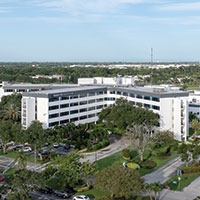 Cleveland Clinic facing big losses at hospital here
Cleveland Clinic facing big losses at hospital here
STORY BY LISA ZAHNER (Week of September 26, 2024)
Citing a perfect storm of runaway inflation, inadequate government reimbursements and soaring labor costs, Cleveland Clinic Indian River Hospital Vice President and Chief Medical Officer Dr. Richard Rothman last week asked the Hospital District to help stanch the hemorrhaging of cash at Vero’s only hospital.
Rothman told the Hospital District, which funds vital programs in the county through more than two dozen nonprofit human service agencies and clinics, that Cleveland Clinic Indian River had an operating loss of $69.2 million in 2023.
“Suffice it to say that operating losses in excess of $60 million are not sustainable,” he said.
How the Hospital District, with an annual budget of less than $22 million per year, could possibly make a significant dent in annual losses of this magnitude is yet to be seen, but the trustees engaged in a robust discussion with Rothman and his top staffers present at the district’s monthly chairman’s meeting.
According to Rothman, charity care at the hospital has increased by 25 percent since Cleveland Clinic took over Indian River Medical Center in 2019, and the total “uncompensated care” in 2023 was nearly $21 million – a figure which he expected to be even higher by the time 2024 comes to a close.
Before Cleveland Clinic, Hospital District Chair Marybeth Cunningham said local taxpayers were funding between $5 million and $6.5 million per year for indigent care at the Vero hospital through property taxes, with the independent hospital’s losses or write-offs totaling between $11 million and $12 million per year.
The conversation began because Hospital District Trustee Paul Westcott had urged the board to exercise more oversight of how Cleveland Clinic delivers indigent care, as that care is an important term of Cleveland Clinic’s 75-year lease of the hospital buildings and land owned by the county taxpayers.
“Instead of giving us volumes of paper, he agreed to come and talk to us about it,” Cunningham said.
Rothman explained that Cleveland Clinic is committed to continue taking care of the county’s neediest people, but that it would need from the Hospital District for at least the next two years until hoped-for changes in healthcare legislation, plus Medicaid expansion, can be pursued.
“If we conceptually agree that we want to continue to offer these services in the community that we’re committed to offering,” Rothman said, “what does it look like for us to come up with some type of short term arrangement to help us bridge this as our teams are working with Tallahassee?”
District Trustee Karen Deigl said it sounded like the number that they needed to focus on is the $10 million to $11 million difference between what Indian River Medical Center lost each year due to unpaid services, and the losses for unpaid services that Cleveland Clinic has been posting annually.
The trustees asked Rothman to bring a strategic plan back for them to consider, which he agreed to do.
When the average person thinks of hospital write-offs, they think of indigent or charity care – which the Cleveland Clinic Foundation is expected, as part of its agreement with the hospital district, to provide to those in need – and uncollectible debt from patients who do not pay.
But on top of that, there is care for patients that Medicare and Medicaid technically do “cover,” but with inadequate reimbursements.
Prior to the Covid-era inflation initially caused by supply chain issues, Medicare and Medicaid reimbursement rates already were not covering the hospital’s costs. Then the cost of everything went up – food, chemicals, medications, utilities and labor costs.
At the same time, the reimbursement rates that Medicare and Medicaid pay the doctors and the hospital did not keep pace with rising costs. While the compounded annual inflation rate has resulted in a more than 20 percent increase in general costs, for hospitals the cost increase has been 40 percent, Rothman showed on a chart. Meanwhile, Medicare reimbursements have only risen 5.2 percent in that same time period.
Rothman explained that for certain cancer treatments administered by infusion by the hospital’s oncology staff, Medicare does not even reimburse Cleveland Clinic enough to cover the wholesale cost of the medications, so a portion of the medication cost, plus the cost of the facility, the equipment, the clinical personnel become part of what’s called “uncompensated care.”
“Our commitment was to expand services,” Rothman said, and Cleveland Clinic has done that. “But each time we bring in a service, we’re not only offering it to people who are able to pay. We’re offering it to everyone,” he said.
Rothman said 70 percent of the hospital’s funding comes from government reimbursements, most of it from Medicare. He said the hospital loses, on average, at least 6 percent on each Medicare patient it treats, but in an acute case, or when a Medicare recipient needs a very expensive treatment or surgery, the loss can be much greater.
During the Covid health emergency, millions of new Americans qualified for Medicaid coverage. During that time period, Indian River County had about 33,000 people on Medicaid. But in 2023 when the Covid emergency ended, Medicaid recipients were re-evaluated and roughly one third lost their health benefits.
Now if they fall under 250 percent of the poverty line and cannot pay, those county residents qualify for charity care. If they don’t qualify or don’t apply, they may just not pay their hospital bill and go into the uncollectible category. Either way, it’s uncompensated care, and Rothman said action by the state government is needed to address this problem.
“But things are not likely to change in the next 24 months,” Rothman said.
An effort is underway to place a state constitutional amendment on the 2026 general election ballot asking voters to expand Medicaid under the federal Affordable Care Act, as 40 states have done.



